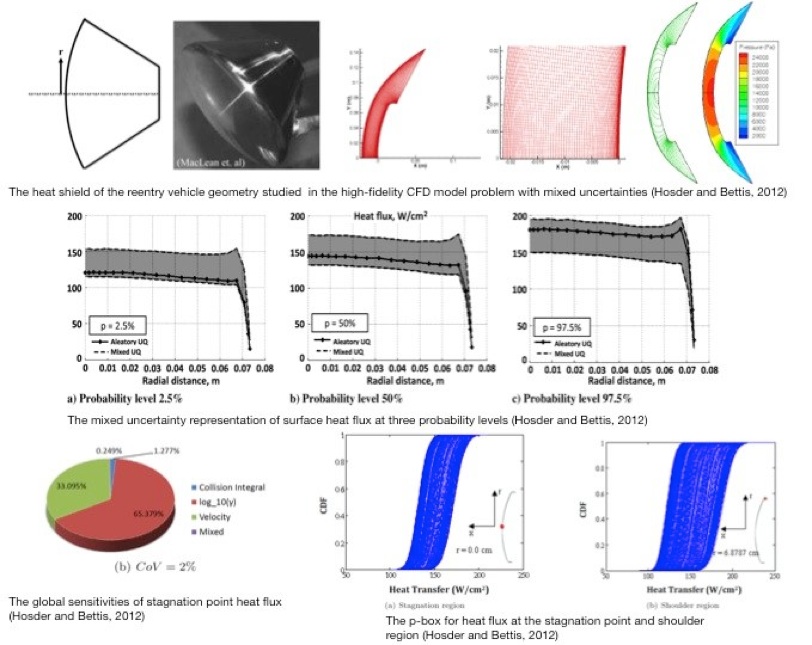AEROSPACE SIMULATIONS LABORATORY
Uncertainty Quantification in Hypersonic Flow Simulations and Aerospace Systems Models
High-Fidelity hypersonic CFD simulations, which are used for the simulation of high temperature, high-speed, chemically-reacting, laminar or turbulent flows with non-equilibrium thermo-chemistry are needed for the analysis and design of various hypersonic configurations including planetary reentry capsules, hypersonic cruise vehicles, and wave-riders. The uncertainties associated with operating conditions (inherent uncertainties) and uncertainties in various physical models used in high-enthalpy hypersonic flow simulations (model-form or epistemic uncertainties) can have significant effects on the accuracy of the results used in the design of various vehicle systems including the thermal protection system (TPS). It is important to include both types of uncertainty in the simulations to properly assess the accuracy of the results and to design robust and reliable reentry or hypersonic cruise vehicle configurations. Similarly, integrated aerospace systems simulations (e.g., integrated spacecraft systems models) can have significant amount of uncertainty coming from the models used in different disciplines (e.g., aerodynamics, structures, materials, etc.).
The uncertainty quantification both in high-fidelity hypersonic CFD and the integrated aerospace system simulations can be challenging due to the computational expense of the simulations, existence of both model-form and inherent uncertainty sources, large number of uncertain variables, and highly non-linear relations between the uncertain variables and the output response variables. Our current research is geared towards addressing these challenges by developing advanced uncertainty quantification and sensitivity analysis techniques based on stochastic expansions to achieve both computational efficiency and accuracy in stochastic hypersonic flow and aerospace simulations.
The research activities in this area are funded by NASA Jet Propulsion Laboratory (JPL) and M4 Engineering, Inc.
Selected publications on the research topic:
1. S. Hosder and Benjamin Bettis, "Uncertainty and Sensitivity Analysis for Reentry Flows under Inherent and Model Form Uncertainties," AIAA Journal of Spacecraft and Rockets, Volume 49, No. 2, pages 193-206, 2012.
2. B. Bettis and S. Hosder, "Efficient Uncertainty Quantification Approach for Reentry Flows with Mixed Uncertainties," AIAA Journal of Thermophysics and Heat Transfer, Volume 25, No. 4, pages 523-535, 2011.
3. S. Hosder, R. W. Walters, and M. Balch, "Point-Collocation Non-Intrusive Polynomial Chaos Method For Stochastic Computational Fluid Dynamics", AIAA Journal, Volume 48, Number 12, pages 2721-2730, 2010.
4. T. Winter, B. Bettis, and S. Hosder, "Development of an Efficient Uncertainty Quantification Framework Applied to an Integrated Spacecraft System." AIAA Space 2011 Conference and Exposition, Paper No. AIAA-2011-7155, Long Beach CA, 27-29 September 2011.
5. B. Bettis, S. Hosder, and T. Winter, "Efficient Uncertainty Quantification in Multi-Disciplinary Analysis of a Reusable Launch Vehicle," 17th AIAA International Space Planes and Hypersonic Systems and Technologies Conference, Paper No. AIAA-2011-2393, San Francisco, CA, April 2011.
6. S. Hosder, R. W. Walters, "Non-Intrusive Polynomial Chaos Methods for Uncertainty Quantification in Fluid Dynamics," 48th AIAA Aerospace Sciences Meeting and Exhibit, Paper No. AIAA-2010-0129, Orlando, FL, Jan. 2010. (Invited Paper)
7. M. Balch, S. Hosder, and R. W. Walters, "Modeling and Propagation of Physical Parameter Uncertainty in a Mars Atmosphere Model," 46th AIAA Aerospace Sciences Meeting and Exhibit, Paper No. AIAA-2008-450, Reno, NV, Jan. 2008.
8. S. Hosder and R. W. Walters, "Non-Intrusive Polynomial Chaos Methods for Stochastic CFD-Theory and Applications," Symposium on "Computational Uncertainty in Military Vehicle Design" NATO Applied Vehicle Technology Panel, RTO-MP-AVT-147, Paper No. 47, Athens, Greece, December 2007.

